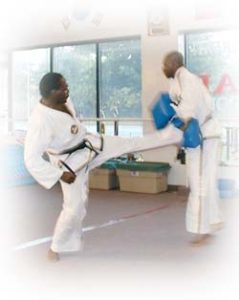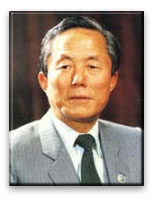Taekwon-Do is an art of self defense which aims at noble moral rearmament, a high degree of intellectual achievement, graceful techniques and beauty of physical form it can be considered as part of one’s daily life, just as are breathing and thinking.
Taekwon-Do is the Korean martial art that was founded April 11, 1955 by General Choi, Hong Hi (9th degree black belt, the highest in Taekwon-Do). In 1965, with the Korean Taekwon-Do movement General Choi received approval from the South Korean Government to declare Taekwon-Do as Korea’s National Martial Art.
 “TAE” means to jump or kick or smash with the feet. “KWON” means to block, punch, kick, strike or smash with the hand or fist. “DO” means an art or way. Thus, Taekwon-Do is the technique of unarmed self-defense involving the skilled application of techniques that include punches, strikes, kicks, blocks, dodges and interceptions with the bare hands, arms and feet, to swiftly overpower an opponent. It instils a spirit of strict self-imposed discipline and the ideal of a noble moral character. Taekwon-Do also cultivates the virtues of courtesy, integrity, perseverance, self-control and indomitable spirit.
“TAE” means to jump or kick or smash with the feet. “KWON” means to block, punch, kick, strike or smash with the hand or fist. “DO” means an art or way. Thus, Taekwon-Do is the technique of unarmed self-defense involving the skilled application of techniques that include punches, strikes, kicks, blocks, dodges and interceptions with the bare hands, arms and feet, to swiftly overpower an opponent. It instils a spirit of strict self-imposed discipline and the ideal of a noble moral character. Taekwon-Do also cultivates the virtues of courtesy, integrity, perseverance, self-control and indomitable spirit.
Taekwon-Do can be traced to Tak Kyon, the art of self-defense, which originated 1,300 years ago during the Silla Dynasty in Korea. Tae Kyon was taught and practiced among the youths of Hwa Rand-Do, who were hand picked to be trained as military leaders of Silla, one of three ruling kingdoms of Korea at that time (the others two kingdoms were Koguryo and Daek-Je.).
March 22, 1966, General Choi founded the International Taekwon-Do Federation in Seoul, Korea with the consent of nine countries, (Vietnam, Malaysia, Singapore, West Germany, The United States, Turkey, Italy, The United Arab Republic and Korea).
In 1974, a tremendous worldwide event took place in the city of Montreal, Canada. The result was the First World Taekwon-Do Championships.



 General Choi was born a weak child and it caused his parents constant anxiety. As a youngster, he studied calligraphy and Taek Kyon under the tutelage of the renowned Ok-Nam Han II Dong.
General Choi was born a weak child and it caused his parents constant anxiety. As a youngster, he studied calligraphy and Taek Kyon under the tutelage of the renowned Ok-Nam Han II Dong.